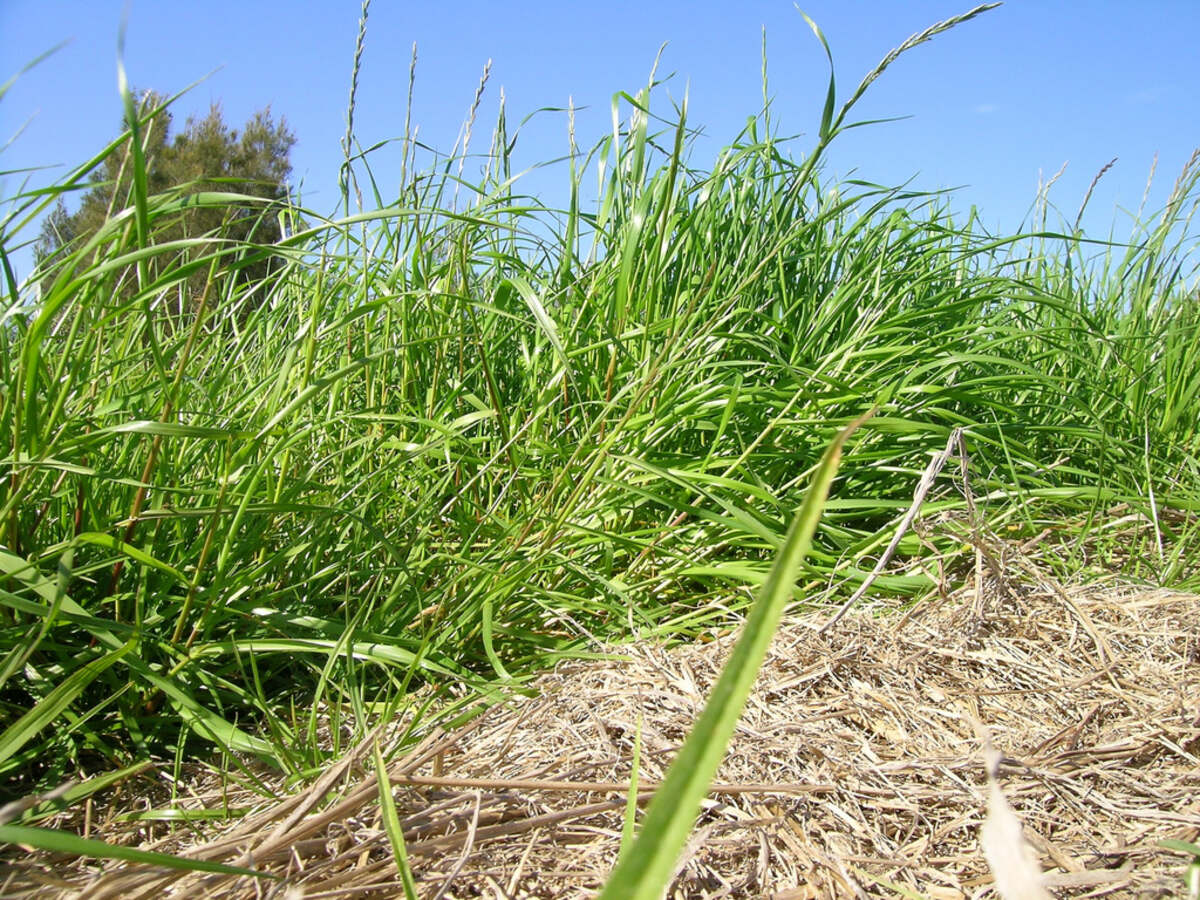Home>Garden Essentials>What Does The Term ET Mean In Turf Grass Management


Garden Essentials
What Does The Term ET Mean In Turf Grass Management
Modified: October 28, 2024
Discover what the term ET means in garden turf grass management, and how it impacts the care and maintenance of your garden.
(Many of the links in this article redirect to a specific reviewed product. Your purchase of these products through affiliate links helps to generate commission for Storables.com, at no extra cost. Learn more)
Introduction
Gardening is a passion for many people, providing a sense of peace and tranquility amidst nature’s beauty. Whether you are a novice gardener or an experienced horticulturist, understanding the intricacies of garden management is essential to ensure the health and vitality of your plants. One crucial aspect of garden management is turf grass maintenance, which involves the care and upkeep of your lawn.
In the world of turf grass management, you may come across an abbreviation that might pique your curiosity: ET. But what exactly does ET mean, and why is it important in maintaining a lush, green lawn? In this article, we will explore the concept of ET in turf grass management, its significance, and how it is measured and utilized to promote optimal turf grass health.
So, let’s dive in and unravel the mystery behind the term ET in the world of turf grass management.
Key Takeaways:
- ET, or Evapotranspiration, measures water loss from soil and plants. Understanding and using ET data helps gardeners water their lawns efficiently, conserve water, and keep their grass healthy.
- Factors like temperature, wind, and plant health affect ET. By managing ET effectively, gardeners can promote deep root growth, prevent overwatering, and maintain a beautiful, resilient lawn.
Read more: What Does Astro Turf Mean
Definition of ET in Turf Grass Management
ET, in the context of turf grass management, stands for Evapotranspiration. Evapotranspiration refers to the combined process of water evaporation from the soil surface and transpiration from plant leaves. It is the natural way in which water moves from the ground into the atmosphere.
In simple terms, ET measures the amount of water lost from the soil and plant surfaces due to evaporation and plant transpiration. It provides valuable information about the water needs of turf grass and plays a crucial role in determining irrigation requirements.
By understanding and monitoring ET, turf grass managers can accurately assess the water needs of their lawns and make informed decisions regarding irrigation schedules and water management practices. ET data is a valuable tool that helps promote efficient water usage, prevent over or under-irrigation, and maintain healthy turf grass.
Understanding ET: Evapotranspiration
Evapotranspiration (ET) is a natural process that occurs when water is evaporated from the soil surface and transpired by plants. It is influenced by several factors, including temperature, humidity, wind speed, solar radiation, and plant characteristics.
When the sun shines on the turf grass, it warms the soil and the plants. As a result, the water stored in the soil is converted into vapor and released into the air through evaporation. Simultaneously, plants take up water from the soil through their roots and release it through small openings called stomata on their leaves. This process is known as transpiration.
Evapotranspiration is a vital process for the health of turf grass as it helps regulate temperature, nutrient uptake, and overall plant growth. It also influences the movement of water within the soil and plays a significant role in the water cycle.
Understanding the factors that affect evapotranspiration is crucial for effective turf grass management. Temperature is one of the primary factors influencing ET. As temperatures rise, evaporation and transpiration rates increase, resulting in higher ET rates. Similarly, low humidity and wind speed can also contribute to increased ET, as they promote faster evaporation.
Solar radiation is another critical factor in the ET process. On sunny days, when the turf grass receives more sunlight, the rate of transpiration is higher, contributing to increased ET. Conversely, during cloudy or overcast days, the rate of transpiration is lower, leading to reduced ET.
Plant characteristics, such as leaf area, canopy density, and stage of growth, also affect ET. Healthy, well-maintained turf grass with a dense canopy will have higher ET rates compared to sparse or damaged grass.
By understanding evapotranspiration and its influencing factors, turf grass managers can make informed decisions on irrigation schedules, water conservation strategies, and overall lawn health maintenance. Monitoring ET helps avoid overwatering, which can lead to water wastage and disease susceptibility, while ensuring the turf grass receives just the right amount of water for optimal growth and vitality.
Importance of ET in Turf Grass Management
Evapotranspiration (ET) plays a crucial role in turf grass management, and understanding its importance is key to maintaining a healthy and vibrant lawn. Here are some reasons why ET is important in the care and maintenance of turf grass:
1. Water Conservation: ET data is used to determine the water requirements of the turf grass. By accurately estimating the amount of water lost through evaporation and transpiration, turf grass managers can optimize irrigation schedules and avoid overwatering, leading to significant water conservation.
2. Preventing Under or Over-Irrigation: By monitoring ET rates, turf grass managers can ensure that their lawns receive the right amount of water. Under-irrigation can result in stressed and weakened grass, while over-irrigation can lead to excessive water consumption, waste, and increased susceptibility to diseases.
3. Promoting Root Growth: Maintaining proper ET levels helps promote healthy root growth in turf grass. Adequate water supply encourages roots to grow deeper, making the grass more resilient to drought conditions. By monitoring ET, managers can avoid shallow roots that are more vulnerable to drought stress.
4. Reducing Disease Risk: Overwatering due to inaccurate irrigation practices can create a moist environment that fosters the growth of fungal diseases in turf grass. By using ET data to schedule irrigation, managers can prevent prolonged moisture on the grass blades and minimize the risk of diseases.
5. Optimizing Fertilizer Application: ET rates also influence nutrient uptake by turf grass. Properly timed fertilization based on ET data ensures that the nutrients are efficiently absorbed, promoting healthy growth and reducing the risk of nutrient runoff, which can be harmful to the environment.
6. Maintaining Aesthetic Appeal: ET management helps maintain the appearance and aesthetic appeal of the lawn by preventing issues like patchy or brown areas. By providing the turf grass with the right amount of water, based on ET rates, managers can promote even and lush growth, creating an inviting and attractive landscape.
By utilizing ET data in turf grass management, professionals can make informed decisions on irrigation, fertilization, and disease control, resulting in healthier and more sustainable lawns. It not only enhances the visual appeal of the landscape but also contributes to efficient water usage and environmental conservation. With a focus on ET, turf grass managers can achieve the perfect balance between a lush, vibrant lawn and responsible water management practices.
Factors Affecting ET in Turf Grass
Evapotranspiration (ET) in turf grass is influenced by several factors that play a role in the rate of water loss from the soil and plants. Understanding these factors is crucial for effective water management and maintaining healthy turf grass. Here are some key factors that affect ET:
1. Temperature: Temperature has a significant impact on ET rates. As temperatures rise, the rate of evaporation and transpiration increases, leading to higher ET. Warm climates with hot summer months will have higher ET rates compared to cooler regions.
2. Humidity: Humidity levels in the atmosphere also affect ET. In humid conditions, the air is already saturated with moisture, making it more difficult for water to evaporate. As a result, ET rates tend to be lower in high humidity environments.
3. Wind Speed: Wind plays a role in the rate of evaporation. Higher wind speeds result in increased airflow over the turf grass, which enhances the evaporation process. Consequently, locations with windy conditions typically experience higher ET rates compared to areas with calmer winds.
4. Solar Radiation: The amount of sunlight the turf grass receives directly affects ET. Solar radiation provides the energy needed to drive the evaporation and transpiration processes. Therefore, areas with higher levels of solar radiation, such as regions with long sunny days, will have higher ET rates.
5. Plant Type: Different types of turf grasses have varying ET rates. Some grass species have higher water requirements and transpire more than others. For example, cool-season grasses like Kentucky bluegrass have higher ET rates compared to warm-season grasses like Bermuda grass.
6. Plant Health: The overall health and condition of the turf grass also impact ET. Well-maintained and healthy lawns have higher transpiration rates, leading to increased ET. Conversely, stressed or damaged grass, such as lawns suffering from disease or drought, may have lower ET rates.
7. Soil Type and Moisture: The type of soil and its moisture content affect ET. Sandy soils drain more quickly and have higher rates of evaporation, resulting in higher ET rates. On the other hand, clay soils retain moisture for longer periods, reducing evaporation and lowering ET.
8. Slope and Drainage: The slope and drainage of the land affect ET rates. Areas with poor drainage may have increased water saturation, leading to reduced ET. Conversely, areas with good drainage allow excess water to flow away, promoting higher ET rates.
Understanding these factors allows turf grass managers to adjust their water management practices accordingly. By considering temperature, humidity, wind, solar radiation, plant type, plant health, soil type, slope, and drainage, managers can optimize irrigation schedules and water conservation efforts, resulting in healthier and more sustainable turf grass. Monitoring these factors and adapting water management practices accordingly ensures that ET rates are effectively utilized for maintaining the optimal health and vitality of the turf grass.
ET in turf grass management stands for “evapotranspiration,” which is the combined process of water evaporation from the soil and transpiration from the plant. Monitoring ET helps determine the water needs of the turf and prevents overwatering.
Read more: What Does Patio Mean
Methods to Measure ET in Turf Grass
Accurately measuring evapotranspiration (ET) is vital for effective turf grass management. Several methods are used to determine ET rates in turf grass, each with its advantages and limitations. Here are some common methods used to measure ET:
1. Weather Stations: Weather stations equipped with sensors can provide valuable data for calculating ET rates. These sensors measure parameters such as temperature, humidity, solar radiation, and wind speed, which are factors influencing ET. This data is then used in mathematical models to estimate ET rates.
2. ET Pans: ET pans are simple, low-cost devices commonly used to estimate ET rates. These pans are filled with water and placed in the turf grass area. As the water evaporates, it indicates the rate of water loss due to ET. By monitoring the water level change, managers can estimate ET rates. However, ET pans provide a general estimation and may not reflect site-specific conditions.
3. Soil Moisture Sensors: Soil moisture sensors are used to measure the moisture content in the soil, which can indirectly indicate ET rates. By monitoring changes in soil moisture levels, managers can estimate the rate of water uptake by plants and, subsequently, ET rates. This method allows for real-time monitoring and adjustment of irrigation practices.
4. Lysimeters: Lysimeters are specialized devices used to directly measure ET rates. These devices consist of a section of turf grass installed in a container with precise weighing mechanisms. The lysimeter accurately measures the amount of water lost through evaporation and transpiration. While highly accurate, lysimeters require complex setup and maintenance.
5. Penman-Monteith Equation: The Penman-Monteith equation is a widely accepted mathematical model used to estimate ET rates. It takes into account various weather variables such as temperature, humidity, solar radiation, wind speed, and plant characteristics. By inputting these variables into the equation, managers can calculate site-specific ET rates.
6. Remote Sensing: Remote sensing involves the use of satellite imagery and other remote sensing technologies to estimate ET rates. These technologies analyze vegetation indices, such as Normalized Difference Vegetation Index (NDVI), to assess plant health and transpiration rates, providing valuable insights into ET. Remote sensing helps in monitoring large areas of turf grass efficiently.
It is important to note that each method has its limitations and considerations, depending on the specific needs and resources available. It is recommended to use a combination of methods to obtain a more comprehensive understanding of ET rates in turf grass. Regular monitoring and analysis of ET data allow turf grass managers to make informed decisions regarding irrigation scheduling, water conservation efforts, and overall lawn health maintenance.
Utilizing ET Data in Turf Grass Irrigation
Evapotranspiration (ET) data plays a crucial role in making informed decisions regarding turf grass irrigation. By understanding and utilizing ET information, turf grass managers can optimize watering practices, conserve water, and ensure the health and vitality of the lawn. Here’s how ET data can be effectively used in turf grass irrigation:
1. Irrigation Scheduling: ET data provides valuable insights into the water needs of turf grass. By monitoring ET rates, managers can determine the optimal timing and frequency of irrigation. Adjusting watering schedules based on ET data prevents over or under-irrigation, ensuring that the grass receives the right amount of water needed for growth and health.
2. Water Conservation: ET data helps optimize water usage by ensuring that irrigation is only applied when necessary. By aligning irrigation practices with ET rates, water waste can be minimized, reducing environmental impact and conserving precious water resources.
3. Smart Irrigation Systems: ET data can be utilized in conjunction with smart irrigation systems. These systems utilize weather and ET data to automatically adjust irrigation schedules and duration. By integrating ET data into smart controllers, managers can achieve efficient and targeted watering, reducing water consumption while maintaining a healthy turf grass.
4. Zoning Irrigation: Turf grass areas with different sun exposure, soil types, and moisture retention capabilities may have varied ET rates. By dividing the lawn into zones based on these factors and adjusting irrigation schedules accordingly, managers can ensure that each zone receives the appropriate amount of water tailored to its unique needs.
5. Monitoring Water Loss: ET data allows managers to estimate the amount of water lost through evaporation and transpiration. By comparing ET rates with the amount of water applied during irrigation, managers can assess the efficiency of their irrigation systems and identify potential water loss issues, such as leaks or inefficiencies.
6. Disease Prevention: Over-irrigation can create a favorable environment for fungal diseases to thrive in turf grass. By utilizing ET data to avoid excess moisture on the grass blades and adjusting irrigation practices accordingly, managers can reduce the risk of diseases and ensure a healthier lawn.
7. Adjusting Irrigation Depth: ET data can guide managers in determining the appropriate irrigation amount to replenish the water lost through evapotranspiration. By calculating the deficit between ET and rainfall, managers can adjust irrigation depth to ensure that the grass receives the necessary water to compensate for the water loss.
By integrating ET data into turf grass irrigation management, managers can optimize watering practices, conserve water, and promote a healthy and sustainable lawn. Regular monitoring and analysis of ET rates, along with adjusting irrigation schedules based on this information, lead to efficient water usage, reduced environmental impact, and a thriving turf grass landscape.
Managing ET for Optimal Turf Grass Health
Effectively managing evapotranspiration (ET) is essential for maintaining optimal turf grass health and vitality. By implementing strategies to address ET in turf grass management, managers can ensure that the lawn receives the right amount of water, maintain appropriate soil moisture levels, and promote overall plant health. Here are some practices for managing ET for optimal turf grass health:
1. Irrigation Efficiency: Efficient irrigation practices are crucial for managing ET. Water should be applied evenly to the lawn, avoiding overwatering or runoff. Utilize technologies such as in-ground sprinkler systems with proper zoning, drip irrigation, or smart controllers that adjust irrigation based on ET data. Regularly monitor the irrigation system for leaks, broken sprinkler heads, or other issues that may lead to water waste.
2. Deep and Infrequent Watering: Instead of frequent light watering, encourage deep watering at longer intervals. This promotes deeper root growth, allowing the turf grass to access water stored in the lower layers of the soil. Deep roots help the grass withstand drought conditions and reduce its dependence on frequent irrigation, which can increase ET rates.
3. Timing of Irrigation: Watering during early morning hours is generally the best time to irrigate. This allows the turf grass to dry out during the day, reducing the risk of disease development. Avoid watering in the late afternoon or evening when the turf grass will remain wet overnight, increasing the chances of fungal growth.
4. Monitor Soil Moisture: Regularly monitor soil moisture levels to ensure that the turf grass receives adequate water. If the soil becomes too dry, the grass may experience stress, leading to discoloration and susceptibility to disease. Conversely, soil that remains excessively wet can cause root rot and other problems. Use soil moisture sensors or perform regular visual inspections to determine when irrigation is needed.
5. Proper Mowing and Fertilization: Maintaining the proper height for your turf grass species and following recommended mowing practices contributes to optimal ET management. Longer grass blades provide shade to the soil, reducing evaporation. Additionally, regular fertilization with appropriate nutrients helps ensure healthy growth and strong roots, aiding in the management of ET.
6. Aeration and Soil Amendments: Aerating the soil helps improve water infiltration and reduces compaction, allowing the roots to access water more easily. Incorporating organic matter, such as compost, into the soil can enhance its water-holding capacity and improve overall soil health, aiding in moisture retention and reducing ET.
7. Monitor and Adjust Based on ET Data: Regularly monitor and analyze ET data specific to your location and turf grass species. By incorporating ET data into your management practices, you can make informed decisions regarding irrigation timing, frequency, and duration. Adjust irrigation schedules and depths based on changes in ET rates to ensure that the lawn receives the appropriate amount of water at the right time.
By implementing these practices, turf grass managers can effectively manage ET, promote water efficiency, and ensure optimal turf grass health. By maintaining the right balance of water, nutrients, and cultural practices, turf grass can thrive and withstand environmental stresses, resulting in a beautiful and resilient lawn.
Conclusion
Understanding and managing evapotranspiration (ET) is crucial for maintaining healthy and vibrant turf grass. By monitoring and utilizing ET data, turf grass managers can optimize irrigation practices, conserve water, and promote overall lawn health. ET provides valuable insights into the water needs of the turf grass and allows for informed decision-making regarding irrigation scheduling, duration, and depth.
Factors such as temperature, humidity, wind speed, solar radiation, and plant characteristics all influence ET rates. By considering these factors, turf grass managers can adjust their watering practices to ensure that the lawn receives the right amount of water at the right time, promoting deep root growth, water conservation, and disease prevention.
Various methods, including weather stations, ET pans, soil moisture sensors, lysimeters, and mathematical models, can be utilized to measure ET rates. It is advisable to combine multiple methods to obtain a comprehensive understanding of site-specific ET rates and water requirements.
By managing ET effectively, managers can also contribute to water conservation efforts and promote sustainable landscaping practices. Implementing practices such as deep and infrequent watering, proper timing of irrigation, monitoring soil moisture levels, and incorporating aeration and soil amendments can all contribute to efficient water usage and healthier turf grass.
Regular monitoring and analysis of ET data based on weather patterns and seasonal changes allow for adjustments in irrigation practices. By aligning irrigation schedules with ET rates, turf grass managers can maintain optimal soil moisture levels, reduce water waste, and create a lush and aesthetically pleasing lawn.
In conclusion, ET is a critical factor to consider in turf grass management. By understanding the concept of evapotranspiration, its influencing factors, and its significance in irrigation, turf grass managers can make informed decisions that lead to healthier, sustainable, and visually appealing lawns. ET management ultimately ensures the longevity and vitality of turf grass, providing a beautiful and enjoyable outdoor environment for all to enjoy.
Frequently Asked Questions about What Does The Term ET Mean In Turf Grass Management
Was this page helpful?
At Storables.com, we guarantee accurate and reliable information. Our content, validated by Expert Board Contributors, is crafted following stringent Editorial Policies. We're committed to providing you with well-researched, expert-backed insights for all your informational needs.















0 thoughts on “What Does The Term ET Mean In Turf Grass Management”